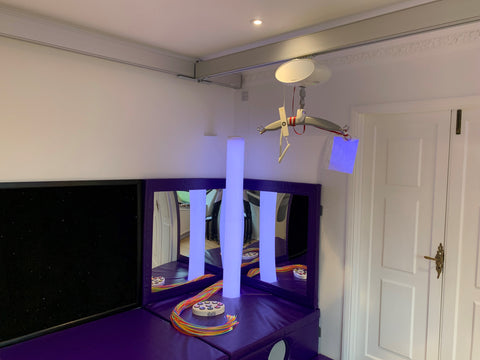20 Tips for Creating & Planning A Sensory Room For The Home

What is a Sensory Room?
A sensory room is a safe space within which a sensory environment is designed to help stimulate and develop the sensory needs of the user. The space is often customised bespoke to the user, helping them to regulate their brain's negative reactions to external factors or stimuli, and can help them to develop coping mechanisms for these experiences. The equipment choice and room layout should be tailored to the users requirements, as every individual is unique and will require the development of different skills to help them cope with the world around them.
How much does a Domestic Home Sensory Project cost?
The cost of a sensory project can vary dramatically-depending on factors such a space available, equipment requirements and your sensory goals. For example, a sensory project could be a whole room design, or a smaller design to fit within a corner of an existing multi-functional room.
Some people choose to build their own sensory room within their home; however they may come across project barriers and limitations if the project planning and design stages have missed out some key considerations.
The Sensorykraft Team are an expert team with a vast range of experience and knowledge when it comes to designing and installing sensory rooms within the home. The team can help you make the most out of your sensory project, maximising the sensory benefits it has to offer, and ultimately helping you to ensure that your project meets the bespoke needs of the intended user(s).
Sensorykraft can offer you a free consultation, quote and 3D room plan. Our sensory experts will tailor your sensory room and customise it to your specific requirements. Our typical domestic home sensory rooms cost between £5,000 - £14,000.

Our 20 Tips for Creating & Planning A Sensory Room For The Home
Preparing The Sensory Room Space
1. A Suitable Space within the Home
Space availability often varies considerably within the home environment. Some families will opt to use a whole room as a dedicated space to be used solely as a sensory room- this may involve converting or utilising a garage, a garden shed/or summer house, a spare bedroom, playroom or an unused box room.
Where space is particularly limited, some may opt to use a segment or section of a pre-existing room, such as within the family living area or the individuals bedroom. There is no right or wrong way of doing this, however all the tips in this planning list should be carefully considered.

2. A Suitable Location within the Home
When trying to decide on a suitable location for your home sensory project, you should consider any potential disruptions which may affect the sensory space when in use. These include noise and people traffic within or immediately around the sensory space. Is it possible that other family members are going to require access to, or via, the sensory space? Are there certain times of the day/night where this may become more of a problem? Will your chosen location allow you to achieve the most out of your sensory room?
Wherever possible, it is ideal to try and avoid locating a sensory space within a busy area of the home. A sensory space which can provide a quiet and calming environment away from distractions and interruptions will be much more beneficial for the user.
3. General Lighting for your Home Sensory Room
Lighting is a key factor when designing your home sensory room. Any windows should be fitted with black-out blinds or curtains to enable you to be able to fully control the lighting and brightness conditions; enabling constant conditions.
Existing room lighting also needs to be considered. You should ensure that any old-style flickering fluorescent tube fittings are replaced with modern LED bulbs or LED down-lighters. The room lighting needs to be easy to control via an ON/OFF switch and is a must for all sensory room or sensory area cleaning and maintenance.
4. Electrics for your Home Sensory Room
Electrical fittings is an essential factor to consider when planning and installing your sensory project. A sufficient number of plug sockets should be available to power and connect all of your sensory equipment. This will enable easy ON/OFF switching for individual components, enabling equipment to be switched on one piece at a time, allowing the user/carer to introduce sensory elements gradually and avoid the risk of 'sensory overload'. Should you wish to install sensory projectors or UV flood lamps, switchable high-level sockets should be considered to neatly power and operate equipment.
5. Ventilation & Heating for your Home Sensory Room
Your home sensory room should have an operable window or air conditioning system available. Fresh air is important to ensure the room air doesn't go stale and you avoid any risk of developing mould. In addition, when the space is cleaned the circulation of fresh air will ensure that the smell of cleaning products doesn't linger. Windows and/or air conditioning can also help cool the room down to avoid it overheating- maintaining a comfortable environment for the user.
Heating is also required. A radiator, ideally with an adjustable thermostat, needs to be close by. In the event that you are concerned about user safety and risk of burning/scolding, consider fitting a wooden radiator cover-these can be sourced from most timber merchants.

6. Room Clutter
Remember 'less is more' when designing your home sensory room- think minimal and tidy. Quite often sensory areas can end up being dumping grounds for other things.You want to avoid your sensory area becoming a place which accumulates 'stuff' and is used for storing home clutter.
After deciding on the location of your sensory space, you should ensure that you keep it completely clear of clutter, other equipment and rubbish. This will help you to maintain a sensory space which is comfortable and safe from trip and fall hazards, clean and hygienic, free of distraction, and focused on the sensory experience at hand.
7. Room Decoration
Room decoration is usually down to the user and the families preference. However, you really can't go wrong with freshly painted walls in white or neutral colours to give the room a clean and spacious feel. Light coloured walls are also ideal for reflecting sensory equipment lighting and maximising the amazing effects of sensory projectors. The light walls will enable projected images and 'story based' fx wheels to be clearly visible for the user to enjoy.
GENERAL ROOM EQUIPMENT & ACCESSIBILITY CONSIDERATIONS
8. Room layout
It is advisable that you design your home sensory room based on a modular raised plinth system which includes additional wall and floor vinyl padding. This design forms the basis of most home sensory rooms as it ticks so many of the essential requirement boxes that a sensory room needs...
- Safe space
- Ideal accessibility for any physical ability
- Easy to keep clean and maintain
- Ideal model for building in additional equipment
- Ideal model for in-built storage space
- Ideal model for installation of in-built audio and vibration systems

9. Accessibility
User accessibility is a key consideration when designing your bespoke sensory project. You need to consider the following:
- Room configuration: Does the sensory space flow well? You should consider a design which avoids trip and fall hazards; location of sensory equipment to ensure best accessibility for user.
- Wheelchair access: Is wheelchair access required? Does your space provide safe wheelchair access? You should consider if your door frames are wide enough to allow wheelchair access; consider if the design ensures floor space is clear; consider if the design enables close positioning of the user to the equipment; safe positioning of sensory equipment and padding to ensure the hoist can be used without difficulties and collisions.
- Mobile or ceiling track hoist use: Is hoist use required? Does your space provide safe hoist access and use? You should consider a design which enables safe hoist transfer between wheelchair and floor padding/ raised plinths; close positioning to equipment; safe manual handling practice; safe positioning of sensory equipment and padding to ensure the hoist can be used without difficulties and collisions.

10. Lockable Storage
When designing your sensory space, it is a good idea to consider if you will require additional storage. Will you require storage space to keep sensory equipment such as musical amplifiers, fidget toys, tablets, charging cables?
A Raised Plinth Modular System can be designed to include an in-built lockable storage cupboard. This helps maximise space elsewhere in the room, whilst providing a safe place to store equipment tidily and conveniently.
This is an ideal feature if your project requires:
- Easy access to music amplifier
- Extra storage space for sensory equipment
- Equipment that needs to be kept out of reach of user
Alternatively, an external padded storage cupboard may be more suitable for your project.

11. Robust Equipment
Equipment choice is a key consideration when designing your sensory project- we can help you to incorporate equipment protection into your plans. Our expert team can advise you on equipment adaptations which can maximise protection of equipment within the sensory space, and importantly, safeguard the user from harm. An example is our robust casing for sensory projectors. The robust design can withstand physical force, wear and tear.
You should consider which equipment is suitable for your space and your user- for example, light tubes and bubble tubes look fantastic and they can be supported using a bracket, but they could still get broken if bashed with force. If user behaviour and user safety is a concern, sensory equipment options such as our snow panel or rhapsody wall panels may be an ideal alternative. These can be wall-mounted flush and be surrounded with padding if required.

12. Maintenance
Maintenance is an important consideration when planning your sensory room. Sensorykraft can help you to expertly design a sensory space which requires low maintenance.
Dirt trap areas need to be kept to a minimum and cleaned regularly. It is advisable that you choose equipment which is easy to wipe clean to promote hygiene- a great example is vinyl padding which is also water resistant and hard wearing with the ability to withstand physical force, wear and tear.
Equipment wise, plan realistically when it comes to maintenance of key equipment such as bubble tubes. Bubble tubes require regular cleaning, whereas light tubes can offer a completely maintenance-free alternative which is just as sensory effective. If a bubble tube was preferred, cleaning kits could be provided.
Sensorykraft rooms are designed with equipment which is configured to be 'ready to use'- no preparation required prior to room use.
Sensory Considerations When Planning The Sensory Room
13. Sensory Requirements: Hyposensitive & Hypersensitive (Passive or Interactive Sensory Experience)
One of the major questions to ask yourself when planning your sensory room project- what sensory experience do we need to achieve for the user? Some users will require a sensory space to enjoy passively, whilst others will require a more interactive sensory experience. There are also some users who will require to use the space for both passive and interactive sensory stimulation; this could be dependent on their mood and/ or sensory seeking needs at the time of room use.

14. Customisation for User Preferences and Interests
To help you get the most out of your sensory room and maximise the sensory experience and benefits for the user, customisation is key. Customisation can range from the colour chosen for the wipe-clean vinyl, through to sensory equipment choices which can provide customisable sensory stimulation tailored to user preference e.g. choice of different songs through a Bluetooth audio system, or use of a colour changing cube which can interactively allow the user to change colours within the room. Keeping the user at the centre of your sensory room design will help you get the most out of your sensory room project.
15. Customisation for User Age and Ability
To ensure that your sensory project is bespoke to your sensory user's needs, age customisation is an important consideration. You will need to consider if the user's age is equal to their abilities. Sensory room projects can be designed for any age, with a whole range of sensory benefits for all. A great equipment choice to consider is a Sensory Projector with magnetic effects wheels; there is a vast number of effect wheels available for the user to enjoy- ranging from tropical fish to nostalgic film stars. Keeping your user and their preferences at the centre of your sensory room design will help you maximise user engagement and the sensory benefits they experience in the home.
16. Sensory Mood Lighting
Sensory mood lighting has been used in various studies with researchers unanimously agreeing that when used correctly, various colours of light can positively influence people's mood and attitude. The sensory mood lighting can help stimulate and balance the sensory system- particularly for those on the autistic spectrum. Sensory lighting can help promote a safe haven for the user, helping to calm their mood and behaviour. With customisable colour control the sensory lighting can transform the sensory space into a bespoke sensory experience, promoting user enjoyment and engagement.
Equipment examples: Ceiling light panel, starlight carpet

17. Sensory Visual Stimulation
Sensory visual stimulation is a truly effective element within a home sensory room environment. Visual stimulation can provide a dynamic experience which encourages user engagement and distraction; helping to soothe mood and behaviour. This distraction can provide a safe haven where the user can go- encouraging deescalation and prevention of behavioural meltdowns. Sensory visual stimulation can also add educational and developmental benefits to the sensory experience, including development of tracking, 'cause and effect' and colour recognition skills.
Equipment examples: Light tube, infinity tunnel, projector

18. Sensory Audio Stimulation
Sensory audio stimulation can be a great sensory addition to a home sensory room. If used correctly, music therapy can create atmosphere which is all-important when creating a feeling of safety and tranquility. Music is a natural sedative, able to induce the release of calming hormones and in turn can help to inhibit the release of stress hormones which would otherwise keep the system highly charged and exacerbate stress and behavioural meltdowns. Sensory audio can therefore be a valuable dynamic to add to the sensory room, helping to create a safe haven within which a user can go and deescalate.
Equipment example: Bluetooth audio system

19. Sensory Tactile Stimulation
Sensory tactile stimulation is recognised by therapists to have very calming effects, which is particularly beneficial for sensory seeking users.
Tactile stimulation is an effective tool for stimulating the body's proprioceptive senses, and can help promote a calming and relaxing experience for the user. There is a wide range of sensory equipment which can provide touch stimulation, enhancing the interactive experience and maximising sensory benefits for the user.
Used correctly, the syncing of audio equipment with tactile vibration can add an effective sensory dynamic and enhance the sensory experience for the user.
Equipment example: Vibration plates, fibre optics, starlight carpets

20. Purchasing Sensory Equipment (including VAT exemption)
When planning your sensory room, the sensory equipment you choose should be carefully considered. Sensory equipment can provide a vast range of sensory stimulation and benefits, but it is important that you understand how they differ. In order to make sure you choose the correct sensory equipment for your project, the intended user needs to be at the centre of your decisions.
Sensorykraft are experts at designing and installing sensory rooms for the home. We can help you to choose the sensory equipment which best meets the bespoke needs of your intended user. We can help you to maximise the sensory benefits achieved within your sensory project budget.
It is worth noting that some individuals are eligible for VAT exemption when purchasing disability and/or sensory products. Finding out if you are eligible could help stretch your project budget further. Sensorykraft can provide relevant VAT exemption paperwork upon receipt of your order.
Sensorykraft Can Help You!
Let the experts help you to achieve your sensory project goals.
Get in touch for a no-obligation Free Sensory Consultation.
Our experts will listen to your requirements and create a 3D room design and quote for your consideration. Should you have any queries in the meantime simply send an email to info@sensorykraft.co.uk or contact us on 0114 2690697.



